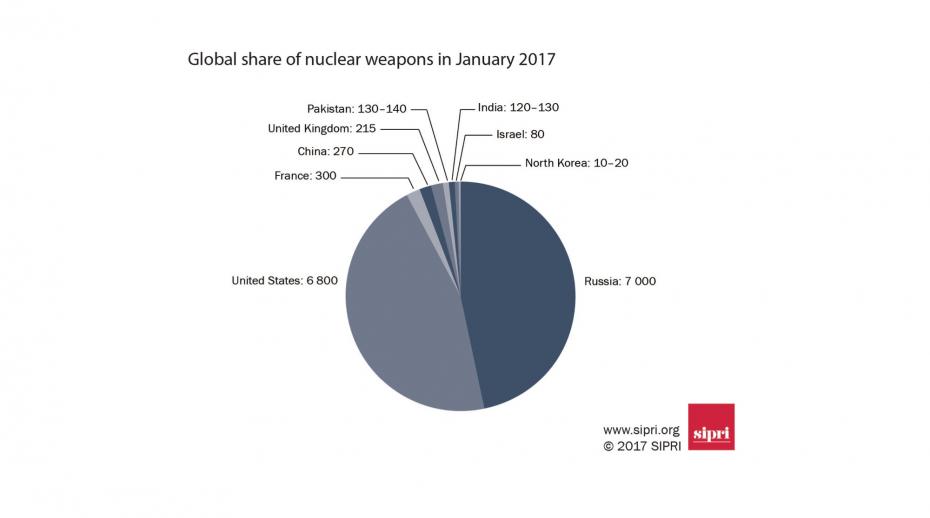
(Stockholm, 3 July 2017) The Stockholm International Peace Research Institute (SIPRI) today launches its annual nuclear forces data, which highlights the current trends and developments in world nuclear arsenals. The data shows that while the overall number of nuclear weapons in the world continues to decline, all of the nuclear weapon-possessing states are in the process of modernizing their nuclear arsenals and will not be prepared to give them up for the foreseeable future.
At the start of 2017 nine states—the United States, Russia, the United Kingdom, France, China, India, Pakistan, Israel and North Korea—possessed approximately 4150 operationally deployed nuclear weapons. If all nuclear warheads are counted, these states together possessed a total of approximately 14 935 nuclear weapons, compared with 15 395 in early 2016 (see table 1).
Table 1. World nuclear forces, 2017
| Country | Year of first nuclear test | Deployed warheads* | Other warheads | Total 2017 |
| USA | 1945 | 1,800 | 5,000 | 6,800 |
| Russia | 1949 | 1,950 | 5,050 | 7,000 |
| UK | 1952 | 120 | 95 | 215 |
| France | 1960 | 280 | 20 | 300 |
| China | 1964 | 270 | 270 | |
| India | 1974 | 120–130 | 120–130 | |
| Pakistan | 1998 | 130–140 | 130–140 | |
| Israel | . . | 80 | 80 | |
| North Korea | 2006 | 10-20 | 10-20 | |
| Total | 4,150 | 10,785 | 14,935 |
* Deployed warheads refers to warheads placed on missiles or located on bases with operational forces. ** Other warheads refers to warheads that are held in reserve or that are retired and awaiting dismantlement.
All estimates are approximate and are as of January 2017. Total figures assume the highest estimate when a range is given and do not include figures for North Korea. Source: SIPRI Yearbook 2017.
Nuclear weapon reductions slow down, investment levels rise
The decrease in the overall number of nuclear weapons in the world is due mainly to Russia and the USA—which together still account for nearly 93 per cent of all nuclear weapons—further reducing their inventories of strategic nuclear weapons. However, despite the implementation of the bilateral Treaty on Measures for the Further Reduction and Limitation of Strategic Offensive Arms (New START) since 2011, the pace of their reductions remains slow. At the same time, both Russia and the USA have extensive and expensive nuclear modernization programmes under way. The USA, for example, plans to spend $400 billion in 2017–26 on maintaining and comprehensively updating its nuclear forces. Some estimates suggest that the USA’s nuclear weapon modernization programme may cost up to $1 trillion over the next 30 years.
‘The projected increases in US spending are not unexpected,’ said SIPRI Associate Senior Fellow Hans Kristensen.* ‘The current US administration is continuing the ambitious nuclear modernization plans set out by President Barack Obama.’
The other nuclear weapon-possessing states have much smaller arsenals, but have all either begun to deploy new nuclear weapon delivery systems or announced their intention to do so. China has started a long-term modernization programme focused on making qualitative improvements to its nuclear arsenal. India and Pakistan are both expanding their nuclear weapon stockpiles and developing their missile delivery capabilities. North Korea is estimated to have enough fissile material for approximately 10–20 nuclear warheads, which is an increase on the estimates for previous years. North Korea carried out an unprecedented number of flight tests of different missile systems in 2016 with mixed results.
‘Despite the recent progress in international talks on a treaty banning nuclear weapons, long-term modernization programmes are under way in all nine states,’ said SIPRI Senior Researcher Shannon Kile. ‘This suggests that none of these states will be prepared to give up their nuclear arsenals for the foreseeable future.’
For editors
The SIPRI Yearbook is a compendium of cutting-edge information and analysis on developments in armaments, disarmament and international security. Three major Yearbook data sets have already been pre-launched in 2017: ‘The top 100 arms-producing companies’ (5 December 2016), ‘International arms transfers’ (20 February 2017) and ‘World military expenditure’ (24 April 2017).
SIPRI Yearbook 2017 is published by Oxford University Press and will be available later in 2017. Learn more at www.sipriyearbook.org.
* Hans M. Kristensen (Denmark) is the Director of the Nuclear Information Project at the Federation of American Scientists (FAS).




